Xin Tong
The Bayesian Origin of the Probability Weighting Function in Human Representation of Probabilities
Oct 06, 2025Abstract:Understanding the representation of probability in the human mind has been of great interest to understanding human decision making. Classical paradoxes in decision making suggest that human perception distorts probability magnitudes. Previous accounts postulate a Probability Weighting Function that transforms perceived probabilities; however, its motivation has been debated. Recent work has sought to motivate this function in terms of noisy representations of probabilities in the human mind. Here, we present an account of the Probability Weighting Function grounded in rational inference over optimal decoding from noisy neural encoding of quantities. We show that our model accurately accounts for behavior in a lottery task and a dot counting task. It further accounts for adaptation to a bimodal short-term prior. Taken together, our results provide a unifying account grounding the human representation of probability in rational inference.
Neural Beam Field for Spatial Beam RSRP Prediction
Aug 09, 2025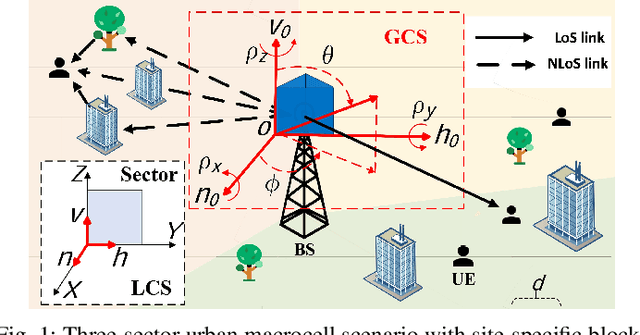
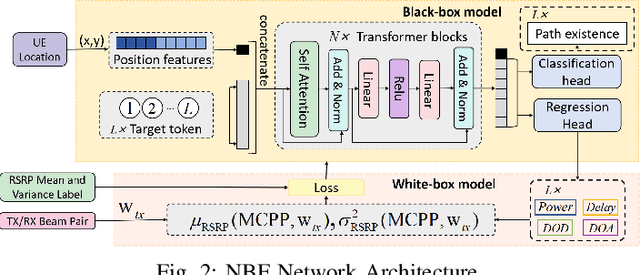
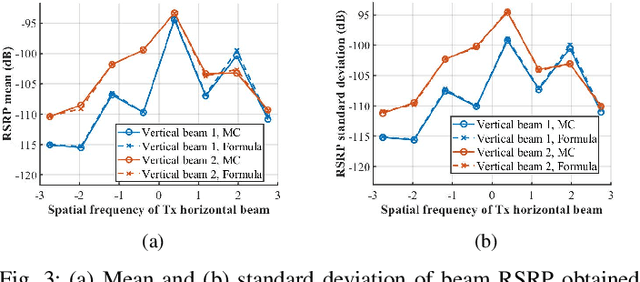
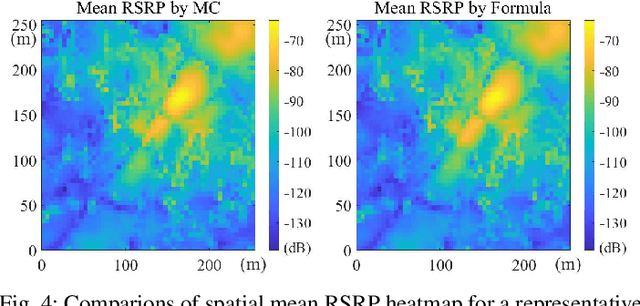
Abstract:Accurately predicting beam-level reference signal received power (RSRP) is essential for beam management in dense multi-user wireless networks, yet challenging due to high measurement overhead and fast channel variations. This paper proposes Neural Beam Field (NBF), a hybrid neural-physical framework for efficient and interpretable spatial beam RSRP prediction. Central to our approach is the introduction of the Multi-path Conditional Power Profile (MCPP), which bridges site-specific multipath propagation with antenna/beam configurations via closed-form analytical modeling. We adopt a decoupled ``blackbox-whitebox" design: a Transformer-based deep neural network (DNN) learns the MCPP from sparse user measurements and positions, while a physics-inspired module analytically infers beam RSRP statistics. To improve convergence and adaptivity, we further introduce a Pretrain-and-Calibrate (PaC) strategy that leverages ray-tracing priors and on-site calibration using RSRP data. Extensive simulations results demonstrate that NBF significantly outperforms conventional table-based channel knowledge maps (CKMs) and pure blackbox DNNs in prediction accuracy, training efficiency, and generalization, while maintaining a compact model size. The proposed framework offers a scalable and physically grounded solution for intelligent beam management in next-generation dense wireless networks.
RecGPT Technical Report
Jul 30, 2025



Abstract:Recommender systems are among the most impactful applications of artificial intelligence, serving as critical infrastructure connecting users, merchants, and platforms. However, most current industrial systems remain heavily reliant on historical co-occurrence patterns and log-fitting objectives, i.e., optimizing for past user interactions without explicitly modeling user intent. This log-fitting approach often leads to overfitting to narrow historical preferences, failing to capture users' evolving and latent interests. As a result, it reinforces filter bubbles and long-tail phenomena, ultimately harming user experience and threatening the sustainability of the whole recommendation ecosystem. To address these challenges, we rethink the overall design paradigm of recommender systems and propose RecGPT, a next-generation framework that places user intent at the center of the recommendation pipeline. By integrating large language models (LLMs) into key stages of user interest mining, item retrieval, and explanation generation, RecGPT transforms log-fitting recommendation into an intent-centric process. To effectively align general-purpose LLMs to the above domain-specific recommendation tasks at scale, RecGPT incorporates a multi-stage training paradigm, which integrates reasoning-enhanced pre-alignment and self-training evolution, guided by a Human-LLM cooperative judge system. Currently, RecGPT has been fully deployed on the Taobao App. Online experiments demonstrate that RecGPT achieves consistent performance gains across stakeholders: users benefit from increased content diversity and satisfaction, merchants and the platform gain greater exposure and conversions. These comprehensive improvement results across all stakeholders validates that LLM-driven, intent-centric design can foster a more sustainable and mutually beneficial recommendation ecosystem.
MoGe-2: Accurate Monocular Geometry with Metric Scale and Sharp Details
Jul 03, 2025


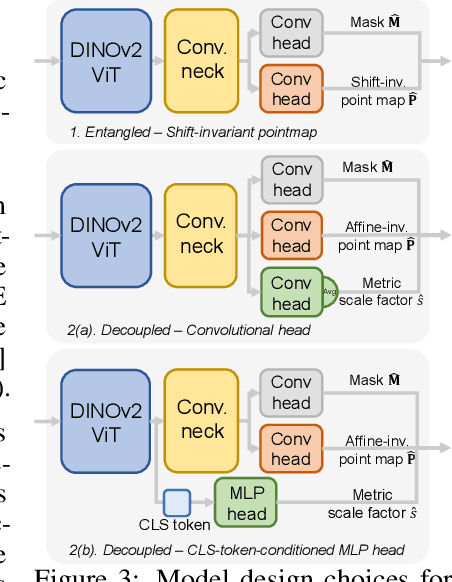
Abstract:We propose MoGe-2, an advanced open-domain geometry estimation model that recovers a metric scale 3D point map of a scene from a single image. Our method builds upon the recent monocular geometry estimation approach, MoGe, which predicts affine-invariant point maps with unknown scales. We explore effective strategies to extend MoGe for metric geometry prediction without compromising the relative geometry accuracy provided by the affine-invariant point representation. Additionally, we discover that noise and errors in real data diminish fine-grained detail in the predicted geometry. We address this by developing a unified data refinement approach that filters and completes real data from different sources using sharp synthetic labels, significantly enhancing the granularity of the reconstructed geometry while maintaining the overall accuracy. We train our model on a large corpus of mixed datasets and conducted comprehensive evaluations, demonstrating its superior performance in achieving accurate relative geometry, precise metric scale, and fine-grained detail recovery -- capabilities that no previous methods have simultaneously achieved.
ReverB-SNN: Reversing Bit of the Weight and Activation for Spiking Neural Networks
Jun 09, 2025Abstract:The Spiking Neural Network (SNN), a biologically inspired neural network infrastructure, has garnered significant attention recently. SNNs utilize binary spike activations for efficient information transmission, replacing multiplications with additions, thereby enhancing energy efficiency. However, binary spike activation maps often fail to capture sufficient data information, resulting in reduced accuracy. To address this challenge, we advocate reversing the bit of the weight and activation for SNNs, called \textbf{ReverB-SNN}, inspired by recent findings that highlight greater accuracy degradation from quantizing activations compared to weights. Specifically, our method employs real-valued spike activations alongside binary weights in SNNs. This preserves the event-driven and multiplication-free advantages of standard SNNs while enhancing the information capacity of activations. Additionally, we introduce a trainable factor within binary weights to adaptively learn suitable weight amplitudes during training, thereby increasing network capacity. To maintain efficiency akin to vanilla \textbf{ReverB-SNN}, our trainable binary weight SNNs are converted back to standard form using a re-parameterization technique during inference. Extensive experiments across various network architectures and datasets, both static and dynamic, demonstrate that our approach consistently outperforms state-of-the-art methods.
Empowering Economic Simulation for Massively Multiplayer Online Games through Generative Agent-Based Modeling
Jun 05, 2025Abstract:Within the domain of Massively Multiplayer Online (MMO) economy research, Agent-Based Modeling (ABM) has emerged as a robust tool for analyzing game economics, evolving from rule-based agents to decision-making agents enhanced by reinforcement learning. Nevertheless, existing works encounter significant challenges when attempting to emulate human-like economic activities among agents, particularly regarding agent reliability, sociability, and interpretability. In this study, we take a preliminary step in introducing a novel approach using Large Language Models (LLMs) in MMO economy simulation. Leveraging LLMs' role-playing proficiency, generative capacity, and reasoning aptitude, we design LLM-driven agents with human-like decision-making and adaptability. These agents are equipped with the abilities of role-playing, perception, memory, and reasoning, addressing the aforementioned challenges effectively. Simulation experiments focusing on in-game economic activities demonstrate that LLM-empowered agents can promote emergent phenomena like role specialization and price fluctuations in line with market rules.
RenderFormer: Transformer-based Neural Rendering of Triangle Meshes with Global Illumination
May 28, 2025Abstract:We present RenderFormer, a neural rendering pipeline that directly renders an image from a triangle-based representation of a scene with full global illumination effects and that does not require per-scene training or fine-tuning. Instead of taking a physics-centric approach to rendering, we formulate rendering as a sequence-to-sequence transformation where a sequence of tokens representing triangles with reflectance properties is converted to a sequence of output tokens representing small patches of pixels. RenderFormer follows a two stage pipeline: a view-independent stage that models triangle-to-triangle light transport, and a view-dependent stage that transforms a token representing a bundle of rays to the corresponding pixel values guided by the triangle-sequence from the view-independent stage. Both stages are based on the transformer architecture and are learned with minimal prior constraints. We demonstrate and evaluate RenderFormer on scenes with varying complexity in shape and light transport.
* Accepted to SIGGRAPH 2025. Project page: https://microsoft.github.io/renderformer
A Survey of LLM $\times$ DATA
May 24, 2025Abstract:The integration of large language model (LLM) and data management (DATA) is rapidly redefining both domains. In this survey, we comprehensively review the bidirectional relationships. On the one hand, DATA4LLM, spanning large-scale data processing, storage, and serving, feeds LLMs with high quality, diversity, and timeliness of data required for stages like pre-training, post-training, retrieval-augmented generation, and agentic workflows: (i) Data processing for LLMs includes scalable acquisition, deduplication, filtering, selection, domain mixing, and synthetic augmentation; (ii) Data Storage for LLMs focuses on efficient data and model formats, distributed and heterogeneous storage hierarchies, KV-cache management, and fault-tolerant checkpointing; (iii) Data serving for LLMs tackles challenges in RAG (e.g., knowledge post-processing), LLM inference (e.g., prompt compression, data provenance), and training strategies (e.g., data packing and shuffling). On the other hand, in LLM4DATA, LLMs are emerging as general-purpose engines for data management. We review recent advances in (i) data manipulation, including automatic data cleaning, integration, discovery; (ii) data analysis, covering reasoning over structured, semi-structured, and unstructured data, and (iii) system optimization (e.g., configuration tuning, query rewriting, anomaly diagnosis), powered by LLM techniques like retrieval-augmented prompting, task-specialized fine-tuning, and multi-agent collaboration.
Computational Imaging-Based ISAC Method with Large Pixel Division
May 12, 2025Abstract:One of the key points in designing an integrated sensing and communication (ISAC) system using computational imaging is the division size of imaging pixels. If the size is too small, it leads to a high number of pixels that need processing. On the contrary, it usually causes large processing errors since each pixel is no longer uniformly coherent. In this paper, a novel method is proposed to address such a problem in environment sensing in millimeter-wave wireless cellular networks, which effectively cancels the severe errors caused by large pixel division as in conventional computational imaging algorithms. To this end, a novel computational imaging model in an integral form is introduced, which leverages the continuous characteristics of object surfaces in the environment and takes into account the different phases associated with the different parts of the pixel. The proposed algorithm extends computational imaging to large wireless communication scenarios for the first time. The performance of the proposed method is then analyzed, and extensive numerical results verify its effectiveness.
Rotational ultrasound and photoacoustic tomography of the human body
Apr 22, 2025Abstract:Imaging the human body's morphological and angiographic information is essential for diagnosing, monitoring, and treating medical conditions. Ultrasonography performs the morphological assessment of the soft tissue based on acoustic impedance variations, whereas photoacoustic tomography (PAT) can visualize blood vessels based on intrinsic hemoglobin absorption. Three-dimensional (3D) panoramic imaging of the vasculature is generally not practical in conventional ultrasonography with limited field-of-view (FOV) probes, and PAT does not provide sufficient scattering-based soft tissue morphological contrast. Complementing each other, fast panoramic rotational ultrasound tomography (RUST) and PAT are integrated for hybrid rotational ultrasound and photoacoustic tomography (RUS-PAT), which obtains 3D ultrasound structural and PAT angiographic images of the human body quasi-simultaneously. The RUST functionality is achieved in a cost-effective manner using a single-element ultrasonic transducer for ultrasound transmission and rotating arc-shaped arrays for 3D panoramic detection. RUST is superior to conventional ultrasonography, which either has a limited FOV with a linear array or is high-cost with a hemispherical array that requires both transmission and receiving. By switching the acoustic source to a light source, the system is conveniently converted to PAT mode to acquire angiographic images in the same region. Using RUS-PAT, we have successfully imaged the human head, breast, hand, and foot with a 10 cm diameter FOV, submillimeter isotropic resolution, and 10 s imaging time for each modality. The 3D RUS-PAT is a powerful tool for high-speed, 3D, dual-contrast imaging of the human body with potential for rapid clinical translation.
 Add to Chrome
Add to Chrome Add to Firefox
Add to Firefox Add to Edge
Add to Edge